Did you know that the presence of trees lining a road calms the pace of traffic? And that areas along roads with tree canopy tend to experience less crime than places without roadside trees?
Vince Drader (’07) didn’t know those things until he surprised himself with a career path that led to his job in Washington, D.C., as director of communications and development for Casey Trees. The nonprofit is committed to restoring, enhancing and protecting the canopy of the nation’s capital, known as the “City of Trees.”
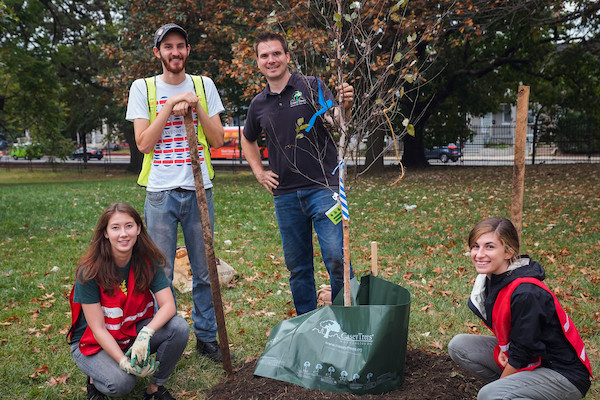
Vince Drader ('07), standing right, at a tree planting in Washington, D.C. Top photo: Drader, director of communications and development for the nonprofit Casey Trees, measures a large tree during a call to the community to search for the largest tree in the District of Columbia in a fun competition. Photos courtesy of Casey Trees
Drader majored at Wake Forest in secondary social studies education and taught history and humanities to high school students as a student teacher. But his trail to self-described tree nerd is littered with acorns holding clues to his future.
He says he has always loved learning and exploring. “I think I’m probably not happy unless I’m learning something new,” he says. And he doesn’t hesitate to dig into new disciplines from the roots up.
He expected to major in music but felt pulled to education. After graduation, he joined the Peace Corps, taught English to high school students in Macedonia and learned its unique Balkan language. He wrote grants for the U.S. Department of State and was drawn into assessing data, despite having no computer science experience. After seven years as data manager at Casey Trees, he took on communications and development in 2022. He has a master’s degree in public administration from the University of the District of Columbia.
Executive Director Mark Buscaino says Drader has everything Casey Trees wants and needs in its leadership team. “He has all the technical skills — that goes without saying. What sets Vince apart is his love for the mission of what we do at Casey Trees, his roots and understanding of the city and region we serve, ability to forge bonds and successfully work with all sorts of people, both within and outside his realm of technical expertise, and — underpinning all that — is the emotional intelligence and humility that make him unique in his role.”
Drader talked with Managing Editor Carol L. Hanner about his journey to tree advocacy. The excerpts have been condensed and edited for clarity.
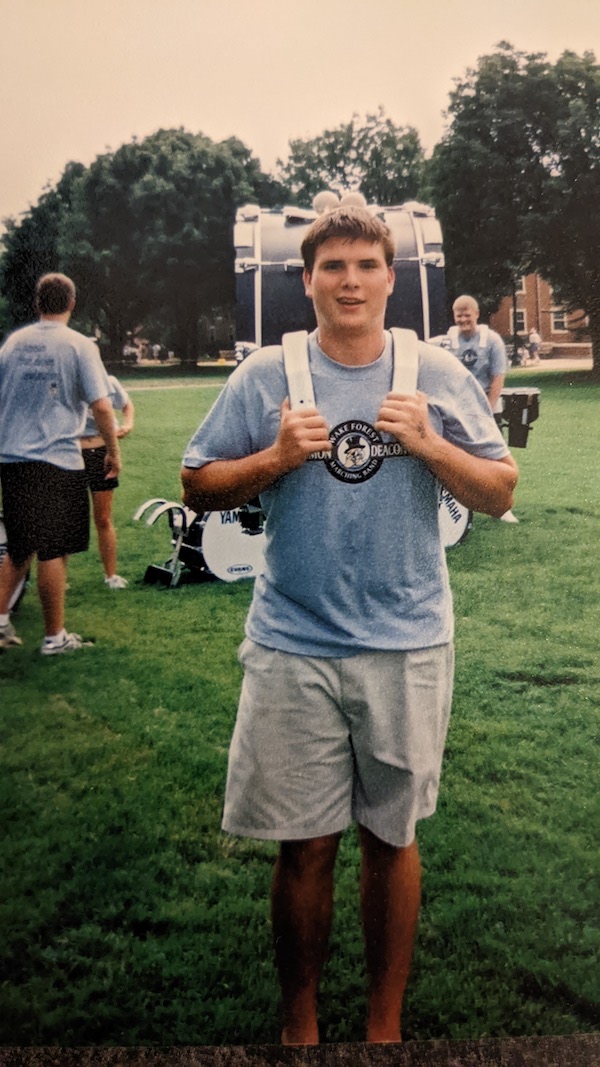
A young Drader ('07) at Wake Forest with his drum on his back. He played in the marching band and eventually became drum major and also played clarinet in the concert band. Photo courtesy of Drader
Tell us about your organization.
Casey Trees is an urban forestry nonprofit. Our city’s goal really is to have a 40% tree canopy by 2032. Right now we’re at 37%. It takes a lot to move it 1%. You wouldn’t think it does, but it does.
We actually lost 1% in the last reporting period we had between 2015 and 2020. That doesn’t sound like a whole lot, but it’s roughly 458 acres of tree canopy. (That’s the equivalent of) the National Mall, just looking all the way down to the water, that whole strip of land.
Our organization is planting trees, caring for trees, protecting trees, trying to grow that canopy to 40%, where everyone has the opportunity to be close to trees in the neighborhood, has access to green areas close by, can visit forest patches within the city.
What are the benefits of a large percentage of canopy besides access to nature?
In urban canopy, it’s really about the fresh air that trees provide, the stormwater retention to help stop flooding events, climate change mitigation. We see that cities remain hot overnight because it’s radiating heat from hard surfaces. The shade that trees provide … curbs that heat island effect.
In the news, there’ll be somebody trying to come up with some machine that sequesters carbon out of the air and puts it into the ground, and I always stop for a second and say, ‘You mean a tree?’ Trees do that already. We just need to plant trees.
As far as physical and mental health, people congregate around trees. We exercise around trees. You are more likely to go run down a trail that has trees or ride your bike down a trail that has trees than one that doesn’t.
Trees help with noise pollution. (Without foliage) sound ricochets everywhere.
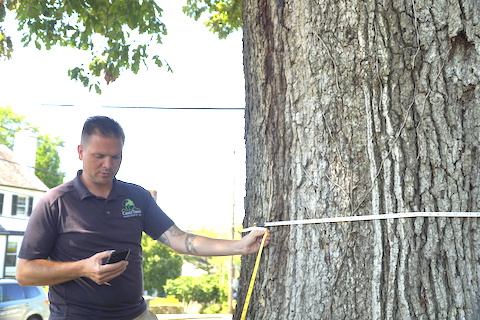
What brought you and your twin brother, Nick Drader (’07), to Wake Forest? (Nick majored in communication and works at Hughes Network Systems in Maryland.)
My mother got hired in the IT department at Wake Forest, (so both her boys got a tuition discount). That was her plan. It might’ve been a plan to keep us close, as well, which worked well. It’s a quality university, obviously, right in our backyard. Growing up, we attended Maple Springs (United) Methodist Church, which is right outside the entrance to Wake Forest. I enjoyed it, and my mom (Cat Drader MALS ’05) took advantage of it, too. She got her master’s (in Liberal Arts Studies) while we were there. So we’re a Wake Forest family.
You started as a music major. What led you to education instead?
(At Wake Forest) I played drums in the marching band. I loved being drum major my senior year. But in concert band, I played clarinet, and that’s what I was going to major in.
The first semester I got a B in individual instruction, and I went to the professor. I said, ‘What can I do better?’ She’s, like, ‘You just need to practice some more. Hit these targets.’ And I remember practicing so hard, my lip got raw from the reed of the clarinet. And then next semester came around, and I think I got an A minus.
And I said, ‘You know what? … I love music enough (that) I think it’s always going to be in my life. It’s going to be a hobby.’ I was two semesters in, and I thought, ‘How can I see myself making an impact in the world while still doing something I love?’”
And it was education. My brother and I both grew up babysitting other people’s kids, especially in the church, so I thought I’d always been great with kids. (He says he was also greatly influenced by former Assistant Professor of Education Ray Jones (MAEd ’92), who was director of secondary social studies education.)
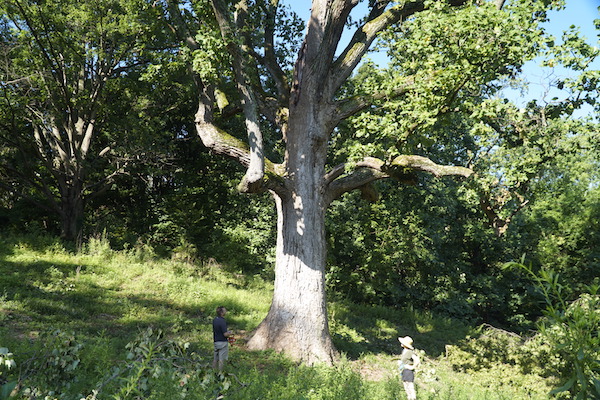
A giant tulip poplar, Drader's favorite tree, dwarfs him under its shade.
How was your time in the Peace Corps in Macedonia?
I mostly taught English classes, and … I liked it some days, didn’t like it some days. I can say that being a teacher is hard, and I think there’s a reason why lots of people burn out. (Overall, the Peace Corps) was a great experience for me. My wife (Amy) was a Peace Corps volunteer, as well, so I met her. So you can find purpose and love in the Peace Corps. (The Draders have a son, Harrison, who turns 10 this month, and a daughter, Julia, 7.)
Good ad for a communications director! You moved next to the State Department.
I thought teaching within the current structure of how schools are, it wasn’t for me. So I moved … more towards international development … (in) a program that brings international visitors from other countries to visit the U.S. on J-1 visas. AIDS workers or doctors around the world would be on programs to come see how we handle the AIDS crisis. We have international chefs, like TV chefs, come in and talk to chefs here. They call that culinary diplomacy. … It’s that soft diplomacy. From there, I started doing data. (He analyzed data in the District of Columbia Public Schools, then in 2015 joined Casey Trees overseeing its Customer Relationship Management data system.)
Could you talk about the fun competition you did in your new role to ask people to help find the largest tree in the city?
We decided to do that as part of a campaign to get people to realize the benefits of our largest trees, right? In D.C. we have laws that protect trees at certain sizes, the largest size being a heritage tree where the trunk’s circumference is over 100 inches. … It depends on the tree species, but it could be 50, 60, 100 years for a tree to grow to a heritage size. And at that size it’s got a huge canopy. … (It will) take several tens of years if we plant 100 small trees to get to even (the equivalent canopy of) one big tree.
That was a campaign to try and get people to look and notice the large trees in their neighborhoods around them. It’s also a fun gamification of a scavenger hunt, and we did find the largest tree, but I’m sure there’s some large tree somewhere else around the city that is just waiting to be found.
What was the largest tree?
It was a champion chestnut oak that is in northwest D.C. on the edge of Battery Kimball Park. It was 105 feet in height and 276 inches (23 feet) in circumference, far past that 100-inch threshold for a heritage tree.
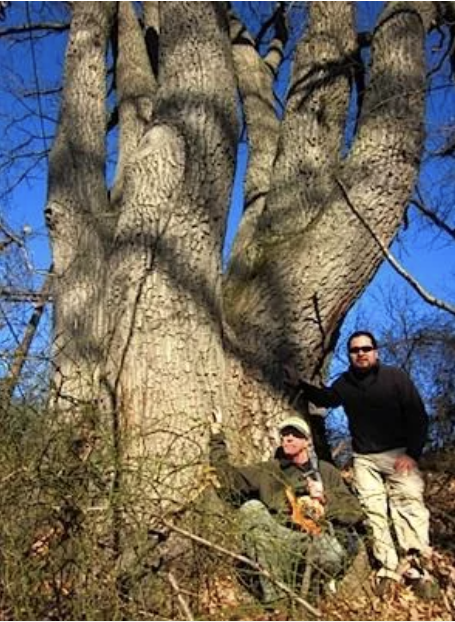
This chestnut oak in northwest D.C. was deemed the largest found in D.C. during Casey Trees' contest. The tree is 23 feet in circumference. This photo appeared on the nonprofit National Parks Traveler website after the tree was catalogued a decade ago by the American Forests Association as a "champion tree," considered the largest recorded tree of its species at the time in the United States. The tree sits in Battery Kimball Park, part of the National Park Service's Rock Creek Park, defended by Union soldiers during the Civil War.
What is your favorite tree?
It changes all the time. For a long time it was a dogwood because I used to see them all around North Carolina, all around campus at Wake. I wish I could say it was magnolias, (but) when I was at Wake, trees were nowhere on my radar. I think now it’s the tulip poplar tree. I really enjoy it.
Do you see trees differently now when you come back to Winston-Salem?
Oh, yeah. I’ve become a total tree nerd in ways that probably annoy people. And if you would’ve told my undergraduate self that this is what I’d be doing and this is what I’d be interested in, I’d be, like, ‘There’s no way.’ But I am.
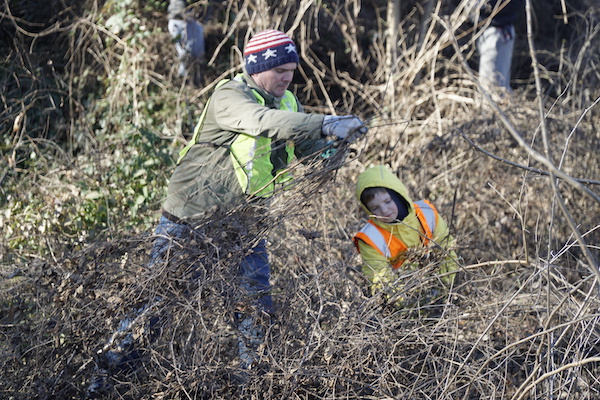
Drader and his son, Harrison, clear an invasive species in a park.


